Fire Alarm Systems
Fire alarm systems detect products of combustion, such as smoke (aerosol particulate), heat, and light, and provide early occupant notification to allow the safe egress of the occupants.
These systems use various methods to detect the products of combustion, including various heat and smoke detection techniques. They use audible and visual alarms to alert and warn building occupants of a fire.
In a residence, a fire alarm system may be composed of a few stand-alone units. Fire alarm systems in large buildings are more sophisticated; they include individual components such as smoke or heat detectors, control panels, fire command centers, communication centers, and alarm horns or speakers.
Smoke Alarms --- A smoke alarm is a fire-safety device that detects the products of combustion and gives off an audible and/or visual warning to building occupants. It is a smoke detector and alarm in one unit. They typically use an audible alarm signal to alert and warn building occupants of a fire. Smoke alarms are typically used in single-family homes, multifamily dwelling. and in some instances, light commercial applications. Ionization and photoelectric are the types of commercially available smoke detectors used in these applications. (These are described later.) Smoke alarms are powered by battery or are hard-wired into the building electrical system with a battery backup. In new construction, hard-wired units are typically required in common spaces on each floor and in bedrooms. (See imgs -22 and -23.)
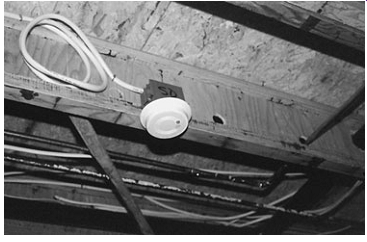
img. 23 A hard-wired smoke alarm in an unfinished ceiling of a residence.
( --)
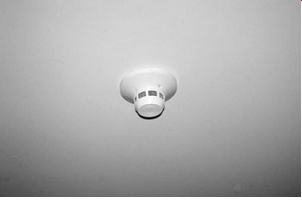
img. 22 A smoke detector in a finished ceiling of a commercial building.
( --)
Smoke and Heat Detectors
A smoke detector is a sensing device that identifies products of combustion in air. Heat detectors are a sensing device that recognizes a high temperature or a rapid increase in temperature. In large buildings, smoke and/or heat detectors are placed in building spaces and in the ductwork of air-handling units. They are then connected to a fire alarm control panel, which is designed to recognize the signal of the detector and alert building occupants of the fire through a separate alarm system. Conventional detectors typically use a signal that is electronically sent to a fire alarm/control panel, where the signal is interpreted. The detector either reports an alarm condition or a normal condition.
Smoke and heat detectors serve as the first line of defense against fire in buildings. They provide an early warning to building occupants, allowing them valuable time to escape a fire. They alert sleeping occupants who would otherwise have been overcome by smoke and toxic gases in their sleep. A description of various detectors follows.
Fixed-Temperature Heat Detectors--- Fixed-temperature heat detectors signal an alarm after the temperature at the detector reaches a set value. A number of fixed temperature designs are available, including what follows:
• Fusible alloy detectors that employ metal alloys de signed to rapidly melt at a desired temperature.
• Bimetallic detectors use sensing elements made of two strips of different metals, each having different thermal expansion coefficients. When the metallic strips are heated, the sensing element deflects, closing the con tact and initiating an alarm.
• Electrical conductivity detectors have a sensing element in which resistance varies as a function of temperature.
• Heat-sensitive cable detectors consist of two current carrying wires separated by heat-sensitive insulation that softens at the rated temperature, thus allowing the wires to make electrical contact.
• Liquid expansion detectors have a sensing element comprising a liquid that expands with an increase in temperature.
Fixed-temperature detectors are more suitable for property protection rather than life safety applications. This is because, in many cases, spaces will be untenable from smoke prior the ceiling temperature reaching the alarm threshold. This depends on the ceiling height, room configuration, and other factors.
Rate-of-Rise Heat Detectors---Rate-of-rise heat detectors signal an alarm when the temperature at the detector increases at a rate exceeding a preset value.
• Pneumatic rate-of-rise detectors have an air chamber with a diaphragm enclosing a portion of the chamber.
Electrical contacts are attached to the diaphragm. The chamber is also provided with an air vent. As the detector is exposed to heat, air within the chamber expands.
The vent is provided to allow the normally expanding air to escape. The vent is sized such that if air within the chamber expands very quickly, it cannot vent enough air to equalize pressures within the chamber. The diaphragm expands to compensate for the increased pressures. As the diaphragm expands, it completes a circuit within the detector and initiates an alarm. Some designs use a tube connected to the diaphragm.
• Electrical conductivity rate-of-rise detectors have a sensing element that changes its resistance with a change in temperature. It is connected to control equipment and sends an alarm when the rate of temperature increase exceeds a preset value.
These detectors respond to temperature changes. If the temperature changes slowly over time, this type of detector will not detect a fire. Rate-of-rise detectors can, in many cases, detect fires more quickly than fixed-temperature detectors, because of the length of time it takes for temperatures at the detector to reach that of fixed-temperature detectors.
Flame Detectors
Flame detectors optically sense high levels of either infrared (IR) radiation or ultraviolet (UV) radiation. Combination UV/IR detectors are also commercially available. A flame emits UV and IR radiation in wavelength ranges that are not emitted by sunlight or artificial lights (e.g., fluorescent, incandescent, metal halide, and so on). These detectors sense specific wavelength ranges of UV or IR radiation and send an alarm signal. Although radiation travels in a straight-line path, either reflector will detect reflected UV or IR radiation off of wall, floor, and ceiling surfaces.
Ionization Smoke Detectors
Ionization smoke detectors are designed with a sensing chamber that has a radioactive element. The chamber has two charged electrodes. The radioactive element charges the air within the chamber, which creates an electrical current between the electrodes. Smoke particles entering the sensing chamber change the electrical balance of the air. The greater the amount of smoke, the higher the electrical imbalance. When combustion particles enter the smoke alarm, they obstruct the flow of the current.
Ionization smoke detectors respond first to fast-flaming fires because these fires produce invisible particles that less than 1 micron in size. They respond less quickly to smoldering fires that tend to generate larger particles. A flaming fire consumes combustibles extremely fast, spreads rapidly, and generates considerable heat with little smoke. Ionization alarms are best suited for rooms that contain highly combustible materials.
These types of material include cooking fat/grease, flammable liquids, newspaper, paint, and cleaning solutions.
Photoelectric Smoke Detectors
Photoelectric smoke detectors use a light scattering or light obscuration principle. They contain a light emitting diode (LED) that is adjusted to direct a narrow IR light across the unit's detection chamber. When smoke particles enter this chamber, they interfere with the beam and scatter the light. A photodiode monitors the amount of light scattered within the chamber. When a preset level of light strikes the photodiode, the alarm is activated.
Photoelectric smoke detectors respond first to slow smoldering fires. A smoldering fire generates large amounts of thick, black smoke with little heat and may smolder for hours before bursting into flames. Because photoelectric smoke detectors function on visible smoke, they are more suitable for detecting large smoke particles produced by smoldering fires.
Photoelectric models are best suited for living rooms, bed rooms, and kitchens. This is because these rooms often contain large pieces of furniture, such as sofas, chairs, mattresses, and countertops, which will burn slowly and create more smoldering smoke than flames. These smoke detectors are also less prone to nuisance alarms in the kitchen area than ionization models.
Air-Sampling Smoke Detectors
Air-sampling smoke detectors use a similar approach to light obscuration detectors, however, a laser or xenon tube is typically used as a light source. Unlike conventional smoke detectors that passively wait for smoke to reach them, air samples are continuously drawn through a sampling pipe network to the detection chamber. A filter assembly screens out large airborne dust particles. Once inside the detector, the samples are ex posed to a light beam that bounces light off small particles released by the combusting materials in the protected area. The scattered light is converted to an electronic signal and passed to the control system.
Air-sampling technology has revolutionized the fire alarm industry and allows for extremely early warning in the event of a fire. Systems can be designed to be 1000 times more sensitive than standard ionization and photoelectric detection systems, yet with proper installation, will not false alarm. This technology is used in applications where downtime is a critical factor.
Heat and smoke detectors are located on ceilings and walls in the spaces they protect. Placement and spacing is determined by ceiling configuration and projections that impede flow of smoke. Other factors include airflow rate, elevation, humidity, and temperature.
Although not a substitute for room-mounted units, heat and smoke detectors are also required in air-handling units. When mounted in ducts, they sense smoke in the air stream. These detectors shut down HVAC equipment to prevent the spread of smoke and heat, and/or to close fire dampers in a zoned system.
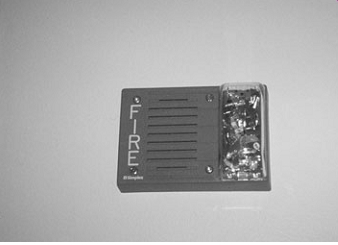
img. 25 A fire alarm with emergency voice communication and warning
(strobe) light capabilities.
Manual Pull Stations
Manual pull stations are lever-like devices mounted on a wall or pole in strategic places in the building and that are connected to a building fire alarm control panel or directly to the municipal or district fire alarm system. When the pull station lever is pulled, an alarm is sounded. Some models are contained behind a glass cover that must be broken before the device can be operated. The need to break the glass cover reduces the frequency of false alarms. Manual pull stations are available commercially in both indoor and weatherproof outdoor models. An ex ample of a manual pull station is shown in img. 24.
Alarms
The most common method of alerting occupants during a fire emergency is an audible evacuation signal delivered through bells, horns, chimes, buzzers, and sirens. Strobe lights are also used in combination with the audible signal to ensure that hearing-impaired occupants recognize the need to evacuate.
Newer systems use voice commands to direct the occupants to evacuate the building.
Most building occupants demonstrate complacent behaviors when audible warning signals are sounded. They either pay no attention to the warning or rationalize that the warning is not influencing their safety. They take too much time to evacuate the building without realizing how they badly they are placing themselves at risk. Studies have shown that people react better to voice instructions as compared to loud sounds or tones. Thus, the use of voice command fire alarm systems has become more commonplace in buildings.
Emergency Voice Communication Systems
An emergency voice communication system provides preprogrammed recorded messages that offer direction, instructions, and a calming voice in an emergency situation. Initial voice messages are preprogrammed and are automatically transmit ted to speakers located throughout the building. Once the fire department and other emergency personnel assess the situation, live instructions may be delivered to certain zones or floors of the building to instruct occupants, relocate occupants to aid fire department operations, or merely reassure remaining occupants of their safety during an incident.
Emergency voice communication systems can also be provided with a two-way communication subsystem. This sub system enables responding firefighters and other emergency personnel to communicate throughout the facility using dedicated two-way communication phone lines with portable hand sets or emergency communication telephone stations provided in remote locations. Although often provided together, this is an independent system and is not always required.
Voice fire alarm systems have been required in high-rise buildings for many years. Fire situations in high-rise buildings are treated differently from fires in typical low-rise buildings.
Occupants in the area of the fire incident and other exposed fire areas must be notified and directed to relocate to a safe area.
The area affected typically includes the floor where the emergency situation is occurring, the floor above, and the floor below. The actual bounds of the area evacuated are based on the overall fire protection program, arrangement of fire areas, and the facility emergency plan. Occupants in other areas of the building are informed of fire conditions by automatic means, advised of the situation, and instructed to wait in their current location until receiving further instructions. A fire alarm with emergency voice communication and warning (strobe) light capabilities is shown in img. 25.
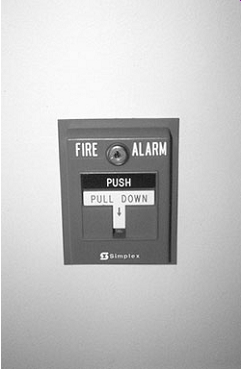
img. 24 A manual pull station. ( --)
Fire Detection and Alarm Systems
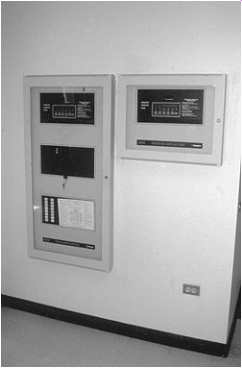
img. 26 A fire command center. ( --)
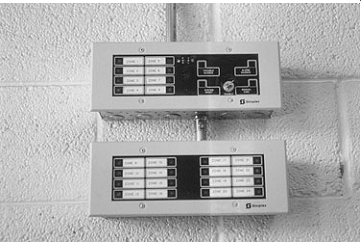
img. 27 A fire status panel. ( --)
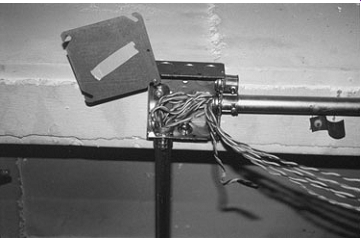
img. 28 Low-voltage wiring for networking a fire alarm and detection
system. ( --)
In medium to large buildings and building complexes, a fire detection and alarm system includes all or some of the following:
• A system control unit
• A primary or main electrical power supply
• A secondary (stand-by) power supply, usually batteries or an emergency generator
• Alarm-initiating devices such as automatic fire detectors, manual pull stations, and/or sprinkler system flow devices, connected to initiating circuits of the system control unit
• Alarm-indicating devices, such as bells or lights, connected to initiating circuits of the system control unit
• Ancillary controls such as ventilation shutdown functions, connected to output circuits of the system control unit
• Remote alarm indication to an external response location, such as the fire department
• Control circuits to activate a fire protection system or smoke control system
The fire system control unit serves as the center of the fire alarm system. The fire alarm control panel is the central part of a fire detection/alarm network in schools, municipal buildings, nursing homes, hospitals, apartment buildings, warehouses, office buildings, retail malls, and department stores. In large buildings, there are several fire system control units.
A fire command center is a remote panel or set of panels connected to the fire system control panels. The command center contains the following:
• Voice fire alarm system panes and controls
• Fire department two-way communication service panels
• Telephone for outside communications
• Sprinkler valve and water flow status panels
• Smoke management controls
• Elevator location status panels and annunciators
• Fire pump status panels
• Emergency generator status panels
A fire detection and alarm system are shown in imgs -26 through -28. The fire command center is typically located at an entrance of the building in a space with a minimum 1-hr fire resistance-rated construction. The location is determined by the jurisdiction having authority (e.g., municipality or special fire district) based on how emergency equipment will first arrive at the site. This location serves as the command center for interior firefighting actions during a fire incident. Large building facilities may have more than one fire command center.
Intelligent fire alarm systems provide useful information on the type of fire and the specific location instead of simply sensing the potential of a fire. These systems provide a unique point identifier that can pinpoint the exact location of the detector sensing a fire. Each detector or alarm is provided with an individual address that can be programmed to give the operator or responding personnel useful information. A detector can be ad dressed to allow the system to identify a room or specific location where the detector is installed. If the detector sends an alarm signal, the system displays a message that informs the operator of its specific location. This information can be useful and thus provide intelligent information.
Operation of the fire alarm control system begins with the smoke or heat detector sensing a fire and sending a signal to the control panel. At the control panel, the signal is processed.
Depending on smoke levels and the preprogrammed alarm levels, the appropriate output signals are generated. The first stage of the three-staged alarm levels (alert) may simply indicate that the system has detected something out of the ordinary that should be investigated. The second stage (action) indicates that a potential fire exists and that emergency procedures should begin. The third stage (fire) signifies an actual fire condition. Once emergency personnel arrive at the scene, they take control of the situation at the fire command center.
Fire alarm control systems can initiate fire suppression by closing of fire doors and dampers that may be otherwise held open to allow normal building function. Where permitted, a fire alarm control system may be combined with other auto mated building operations (e.g., energy management) and/or security stations. A security system can work together with a fire alarm system to enhance the fire alarm system goals. For example, a facility that has a security system is well covered with closed-circuit television surveillance equipment, which can be utilized during a fire incident to visually assess the situation (e.g., determine whether the incident is a small trash can fire or a room is totally engulfed in fire).
Prev: Active Fire Protection and Suppression
Next: Building Security